From the WeChat channel Yao Cheng Rong Yi Quan, 2018-05-11
By Beijing Zhong Yi Wu Guan,
Translated by Per Nyfelt
Practise teaches us about the principles, study teaches us about the method, pair practice teaches us about the result, Zhong Yi Wu Guan has always paid attention to the quality of teaching, focused on the exercise process, and paid close attention to the problems that occurred during the exercise. The direct and practice results are linked. Since the establishment of the Zhong Yi Wu Guan for more than 25 years, teacher Yao Cheng Rong has always been on the first line of instruction, personally instructing and personally demonstrating, solving various problems of the students, and with unremitting effort trained many outstanding students and disciples for the popularisation and promotion of Yi Quan which have been welcomed by the majority of martial arts enthusiasts.
Scan the below QR code to add Yao Cheng Rong public WeChat forum. For more information, please pay attention to (Yao Chengrong Yi Quan) public news.

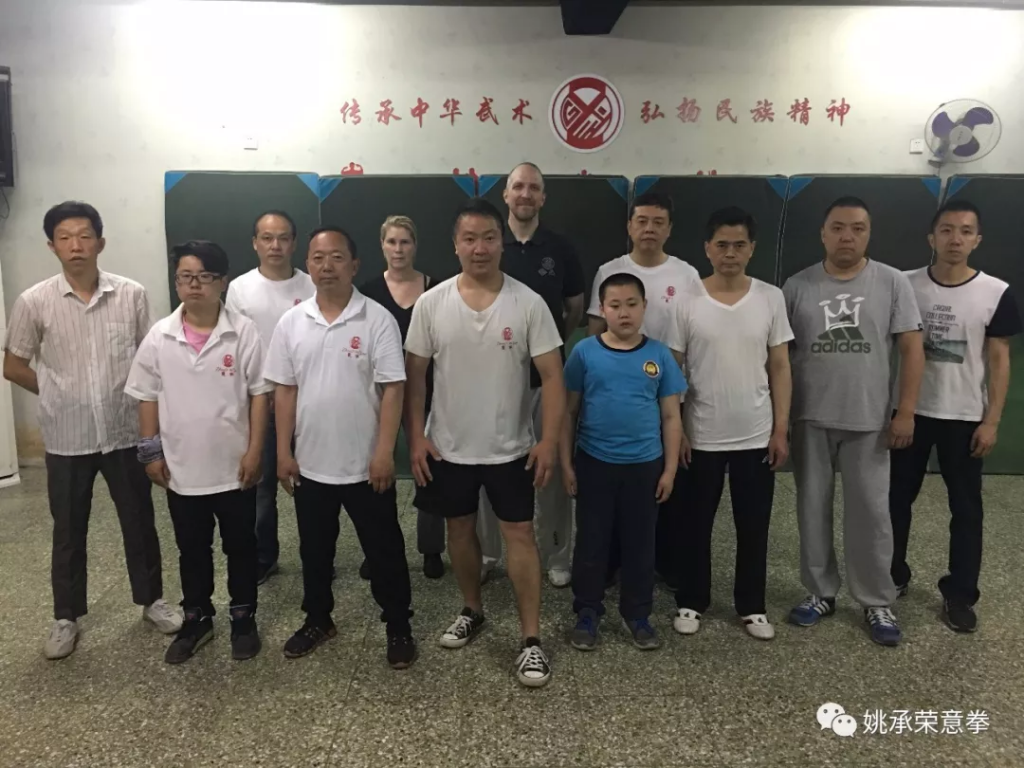
Mister Yao Cheng Rong always pays attention to regularization, standardization and systematization in the training of Yi Quan for the perseverance and development of the art.
In the training of Yi Quan, Yao Cheng Rong emphasizes the theoretical guidance, development of skill (gong fu), the combination of practical combat skill and safe practice, and combined learning and its application. This is the hallmark of Beijing Zhongyi Martial Arts Academy in its many years of teaching!
In Yiquan pushing hands one should pay attention to the process; ignoring the result of the process will inevitably be unsatisfactory. The so-called <process> is whether you have connected your basic skills with every move in your pushing hands. Have you asked yourself how standing post, trial of force, footwork and the issuing of force is put to use in application? How you handle the various circumstances that come up in pushing hands? The question of correct timing, the transformation and changes of applying force, issuing force on the moment of contact, your ability to move and to follow up etc. That’s all important. If you approach pushing hands as always trying to push people to send them away and you don’t pay attention to basic skills training, you will not be able to make the connection between pushing hands and actual combat. The result will not be good. Therefore, the principle of “prevention of symptoms by treatment of the root” is the idea.
Yi Quan pushing hands practitioners should pay attention to the method. It is normal for force against force, brute force, and hardcore resistance to appear during practice. This process will be encountered by most practitioners. How to get through this stage is most important and not easy. I think about it from two aspects: first, the teacher should look with intelligence, observe the problems existing in the students, and come up with adequate and effective methods of improvement, formulate programs, and prescribe the right medicine to get immediate and effective results. Second, the students themselves should pay attention to basic skills training, meticulously and strictly in accordance with the teacher’s requirements, change their bad habits in their practice, transform the thick line exercise mode (clumsy) into thin lines (refined). Try do understand the deeper meaning while exercising, do not use tricks, do not bypass. Solve each problem one by one and look for the true skill in the basic practice. In practice seek finesse in clumsiness, it’s not that one should use fine movements in every point; one should have the spirit that when you walk a hundred miles only reaching ninety can be considered half of the way.
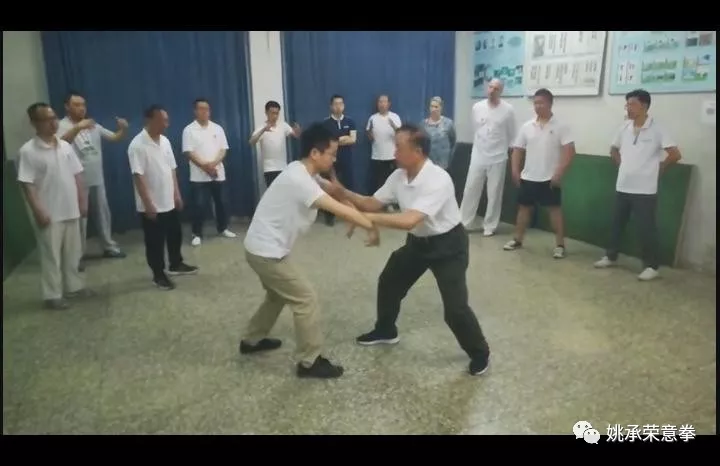
Teacher Yao Cheng Rong instructing students to practice double hands pushing hands.
To Practice Yi Quan properly one must understand the principles, research its methods and emphasize real results. Also one must research how to properly combine the outside movements with internal force and apply it to practical training. In what way can we examine ourselves and understand if we are making progress or not? For example, if you take photos and videos of yourself practising and you compare yourself with videos and photos a few months back, can you see the differences; can you see your own problems? Can you know in your heart that you have made progress? It is also possible to compare in actual confrontation, how the technical level is exerted, how your power is used, how your timing is, and whether the techniques are executed properly. Recently some of my friends like to post videos from their practise from many years ago on the Internet. This can only explain the technical level of your previous period. Did you shoot a recent video so you can see the improvement? Did you do this comparison and analysis? Is there real improvement? What else is missing? We must study every day, check and reflect every day, and make progress every day. Imagine that the contents of a certain number of years ago are always on the Internet. This can only show that this is the level of technology in the early years. It should be complemented with more pictures and videos of current practice. This would be very helpful to many of the friends who love martial arts and has a positive and practical significance for the promotion of martial arts. It is like the saying “taking a boat upstream but not moving upwards but downwards (逆水行舟,不进则退)”. Inheriting and carrying on, developing, and innovating are all very important.
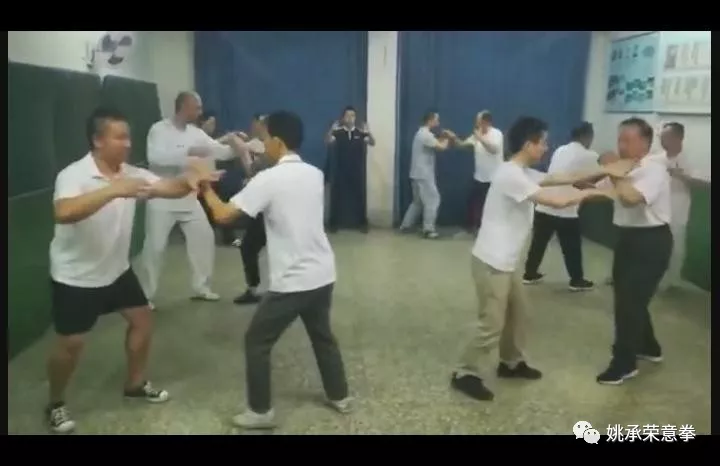
Teacher Yao Cheng Rong instructing students to practice with single and double hands pushing hands.
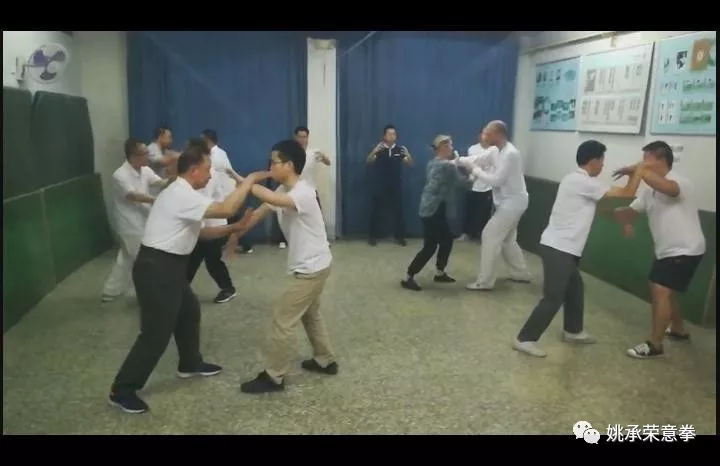
Yi Quan Pushing hands emphasize listening and seeking opportunities to counterattack the opponent on the basis of undermining the other’s balance. You must not lack purpose, practice blindly, eat without loss, or just patiently endure. It is difficult to grasp the opportunity.
Yi Quan push hands should be combined with basic training so that practice is done with purpose and method. When problems are encountered, they must be resolved. You cannot be sloppy about this. Always think that small problems will accumulate into a big problem. With more and more problems accumulating, how can we improve? At Zhong Yi Wu Guan we pay attention to principles and focus on training methods in order to solve the problems that arise in the exercise according to each person’s individual situation. Through tailored teaching and specific guidance significant results are achieved.
In Yi Quan pushing hands one should pay attention to control. The more points that are controlled, the more opportunities you have against the opponent. In order to push the hands well, it is particularly important to practice basic skills such as standing, testing force, footwork, issuing force, and free sparring (sanshou) are all very important to apply in pushing hands. The first thing to understand is that pushing hands is a confrontation in the midst of physical contact. Do not search for pretty and impressive but aim for controlling the opponent. It is to make oneself master the initiative and more comprehensive control; the more opportunities you have, the more you have the initiative. It is just like the saying common in martial arts: “to hit someone is easy but to really control someone is difficult (打人容易控制难).
In Yi Quan pushing hands one should pay attention to control. Quickly turning, pushing and issuing is easy, the ability to move hands and feet freely while in the control of the opponents balance, applying correct timing, applying what one has learned, stability, accuracy, and countering the opponent at the right time is not so easy. Pushing fast is easy but pushing slowly difficult since when you push fast there are a lot of opportunities that you will miss [so it appears falsely as easy], the result of such practise will not be ideal. However if you try to find each opportunity [which is possible when practicing slowly] to control the opponent all the time, you will find that your skill in actual application will increase. Therefore, pushing hands is not better the faster it is but neither is it better the slower it is. There are appropriate measures and degrees according to actual circumstances; to grasp the right opportunity to issue force is what matters.
Teacher Yao Yue is instructing the students to practice Yiquan walking with hooking hands (Zoubu Guo Gua Shili):
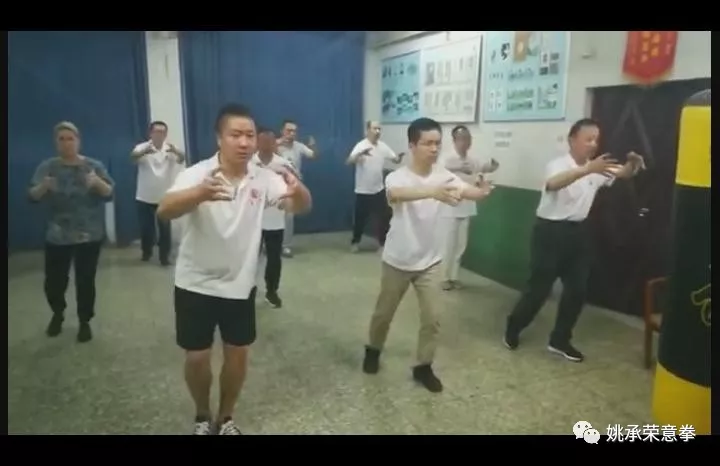
The Zhong Yi martial arts centre pays attention to teaching quality, the combination of study and use, and emphasize real results. It offers classes every day, personally taught be teacher Yao Cheng Rong who is constantly examining the content of his teaching and improving its quality. He has developed many advanced concepts, advanced teaching methods, and are pointing out the key points. He can see in a flash whether the students practice correctly, or when listening to them asking questions whether they got the right understanding or not, and can come up with the best plan for the students to improve. Whether he is giving lectures, teaching movements or hands-on teaching, he has accumulated a rich practical and teaching experience and applied it to his teaching. In life and work, after many years of practice, it has proven to be effective and productive.
Introduction to the Training Course of the Zhong Yi Wu Guan:
Regular classes: Monday, Wednesday, Friday 19:00 – 20:30. Tuesday and Thursday from 14:00 to 16:00. Saturday and Sunday morning from 09:00 to 11:00
Special Classes: Monday to Friday from 09:30 to 11:30, Saturday afternoon from 14:00 to 16:00
The difference between the teaching content of the regular classes and special classes:
Regular classes:
- Basic knowledge of Yi Quan and the principles of practicing
- Working on basic/foundational practices
- Basic practical pair exercises
Special classes:
- Systematic explanation and guidance of the theory of Yi Quan.
- Emphasis is subtleties of the techniques, especially on subtle changes in skills and overall coordination and development of whole body force.
- Practical training combined with explanation and analysis.
- Provide targeted teaching and exercise for students with sub-health or chronic diseases, such as various back problems, insomnia, digestion, blood pressure, heart, etc.
Registered students can choose to report according to their actual situation regardless of skill level and physical condition for individually adapted teaching.
Address for enrolment and practise:
中意武馆地址是,北京西城区新街口正觉夹道十七号宝苑宾馆内二楼217室。
Zong Yi Wu Guan, Beijing Xicheng district, Xin Jie Kou Zheng Jue Jia Dao No 17, Bao Yuan Hotel, Second Floor room 217.
Tel:13011140931 Yao Cheng Rong (姚承荣)
WeChat address: (微信号):ych13011140931
Zhong Yi Wu Guan WeChat public address: <姚承荣意拳>
Take Metro Line 2 to Jishuitan (积水潭) Station and get off at the south station. The Xinjiekou Department Store is just across the street and is 100 meters to the left of Zhengjue Hutong.
Alternatively, Take Subway Line 4 and get off at Xinjiekou (新街口) Station and go east 200 meters.
Alternatively, Take the 22 bus. Take tram 105 to get off at Xinjiekou station.
Zhongyi Wuguan warmly welcomes everyone!
Beijing Zhong Yi Wu Guan also offers training online through our Wechat classes <微信课堂>
In order to satisfy some students who are interested in Yi Quan, but because of many reasons cannot come to the Wu Guan to practise, we have created a WeChat class. Since its inauguration, it has been very popular.
The WeChat class is taught and coached personally by Mr. Yao Chengrong, a famous representative of the third-generation of Yi Quan.
The classes features:
- Targeted, one-on-one teaching.
- Timely answers to questions and answers to students, especially for those students who have sub-health or chronic diseases, etc.
- The teaching methods are diversified, including WeChat teaching, video instruction, and VCD discs as supplementary teaching materials, with phased face-to-face teaching and assessment.
- Teaching content is rich. There are four levels of training courses. Each phase of WeChat is set for one year. There are primary, intermediate, advanced, and special training classes, with an average of 20 teaching materials per period. Every two months, there are 3 to 4 contents as a unit. The contents include health standing, combat standing, testing force, issuing force, push hand, boxing methods, stick methods, using sound (voice), health dance and so on. The content is rigorous and rich. After each term of study expires, it is finally evaluated by face-to-face examination. The qualified person is signed by the master of Yi Quan, Mr. Yao Chengrong, to issue a certificate of completion.
Welcome friends from all walks of life to sign up! To participate in WeChat classes, please contact Yao Chengrong directly.
Registration address:
北京中意武馆,西城区新街口正觉夹道十七号,宝苑宾馆二楼217室。
Zong Yi Wu Guan, Beijing Xicheng district, Xin Jie Kou Zheng Jue Jia Dao No 17, Bao Yuan Hotel, Second Floor room 217. (other details as above)
Teacher Yao Cheng Rong’s personal We Chat:

Scan the above QR code to add Teacher Yao Chengrong’s personal Wechat
For more information, please pay attention to (Yao Chengrong Yi Quan) public news